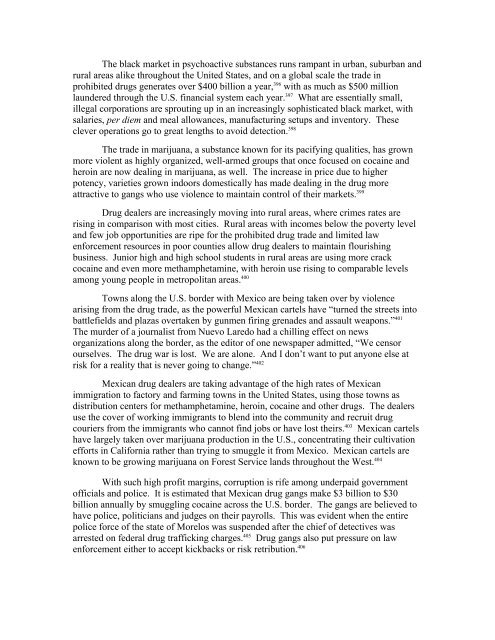Effective Drug Control: Toward A New Legal Framework
Effective Drug Control: Toward A New Legal Framework
Effective Drug Control: Toward A New Legal Framework
Create successful ePaper yourself
Turn your PDF publications into a flip-book with our unique Google optimized e-Paper software.
The black market in psychoactive substances runs rampant in urban, suburban and<br />
rural areas alike throughout the United States, and on a global scale the trade in<br />
prohibited drugs generates over $400 billion a year, 396 with as much as $500 million<br />
laundered through the U.S. financial system each year. 397 What are essentially small,<br />
illegal corporations are sprouting up in an increasingly sophisticated black market, with<br />
salaries, per diem and meal allowances, manufacturing setups and inventory. These<br />
clever operations go to great lengths to avoid detection. 398<br />
The trade in marijuana, a substance known for its pacifying qualities, has grown<br />
more violent as highly organized, well-armed groups that once focused on cocaine and<br />
heroin are now dealing in marijuana, as well. The increase in price due to higher<br />
potency, varieties grown indoors domestically has made dealing in the drug more<br />
attractive to gangs who use violence to maintain control of their markets. 399<br />
<strong>Drug</strong> dealers are increasingly moving into rural areas, where crimes rates are<br />
rising in comparison with most cities. Rural areas with incomes below the poverty level<br />
and few job opportunities are ripe for the prohibited drug trade and limited law<br />
enforcement resources in poor counties allow drug dealers to maintain flourishing<br />
business. Junior high and high school students in rural areas are using more crack<br />
cocaine and even more methamphetamine, with heroin use rising to comparable levels<br />
among young people in metropolitan areas. 400<br />
Towns along the U.S. border with Mexico are being taken over by violence<br />
arising from the drug trade, as the powerful Mexican cartels have “turned the streets into<br />
battlefields and plazas overtaken by gunmen firing grenades and assault weapons.” 401<br />
The murder of a journalist from Nuevo Laredo had a chilling effect on news<br />
organizations along the border, as the editor of one newspaper admitted, “We censor<br />
ourselves. The drug war is lost. We are alone. And I don’t want to put anyone else at<br />
risk for a reality that is never going to change.” 402<br />
Mexican drug dealers are taking advantage of the high rates of Mexican<br />
immigration to factory and farming towns in the United States, using those towns as<br />
distribution centers for methamphetamine, heroin, cocaine and other drugs. The dealers<br />
use the cover of working immigrants to blend into the community and recruit drug<br />
couriers from the immigrants who cannot find jobs or have lost theirs. 403 Mexican cartels<br />
have largely taken over marijuana production in the U.S., concentrating their cultivation<br />
efforts in California rather than trying to smuggle it from Mexico. Mexican cartels are<br />
known to be growing marijuana on Forest Service lands throughout the West. 404<br />
With such high profit margins, corruption is rife among underpaid government<br />
officials and police. It is estimated that Mexican drug gangs make $3 billion to $30<br />
billion annually by smuggling cocaine across the U.S. border. The gangs are believed to<br />
have police, politicians and judges on their payrolls. This was evident when the entire<br />
police force of the state of Morelos was suspended after the chief of detectives was<br />
arrested on federal drug trafficking charges. 405 <strong>Drug</strong> gangs also put pressure on law<br />
enforcement either to accept kickbacks or risk retribution. 406
















